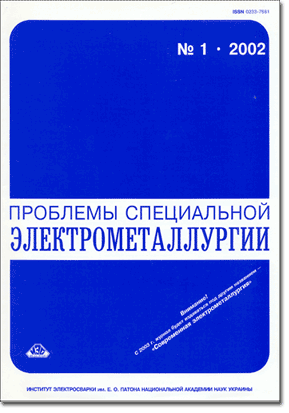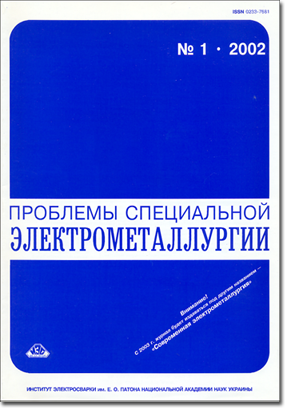| 2001 №04 | 2002 №02 |

CONTENTS

ELECTROSLAG TECHNOLOGY
Paton B.E., Saenko V.Ya., Pomarin Yu.M., Medovar L.B., Grigorenko G.M. and Fedorovsky B.B. Arc-slag remelting - state-of-the-art and prospects of development. P. 2
Peculiarities and technological capabilities of the arc-slag remelting (ASR) method, developed at the E.O. Paton Electric Welding Institute, were considered. The results of experimental and industrial melting of steels and alloys are given. As compared with ESR the ASR method makes it possible to 1.5 times reduce the energy consumption, and also to decrease almost by 2 times the consumption of a synthetic flux per 1 t of metal during melting of ingots. As to the quality, the ASR metal is not inferior to the ESR metal. The main advantage of ASR is a feasibility to alloy metals with nitrogen from the gas phase, including that under pressure, at a complete elimination of expensive nitrogen-containing compounds, for example, silicon nitride, from the technological process of production of high-nitrogen steels and alloys. It is shown that the ASR is also effective in the production of titanium and its alloys and produces ingots with a good surface and high quality. The prospects of ASR further development are outlined.
Kapustin I.V., Akulov V.P., Galushka A.A. and Stovbun N.A. About determination of chemical composition of metal of electroslag remelting. P. 9
Statement of GOST 7565-81, concerning the determination of chemical composition of metal of the electroslag remelting, is considered. It is shown that the composition of metal, sampled from the bottom part of the ESR ingot can differ, according to the recommendations of this GOST, from the metal of the rest part of the ingot in carbon, sulphur, silicon and other easily-oxidizing elements. The sampling is suggested to be made from the top part of the ingot.
Zakharchenko V.I., Skripnik S.V., Chernega D.F., Skripnik V.P., Semenov A.N. and Dudetskaya L.R. Electroslag crucible bifilar furnace ETPB-2.5 with a consumable electrode and a block of non-consumable electrodes. P. 10
The design diagram of the electroslag crucible furnace for utilization of metal rejections, in particular large dies, has been suggested. The technological variants of remelting composite consumable electrodes from metal rejections of large sections using the water-cooled non-consumable electrodes were developed. The installation can produce liquid metal of up to 2.5 t mass of the required composition under the conditions of machine-building enterprise with use of their own metal rejections.
ELECTRON BEAM PROCESSES
Paton B.E., Zhuk G.V. and Trigub N.P. Effect of initial cooling rates in solidification on structure of heat-resistant nickel alloys. P. 13
Suggested is the method of electron beam hot spraying for producing structural materials out of a dispersed melt. The method combines advantages of granulating and casting technologies. The mathematical model of thermal processes of solidification of a dispersed melt has been developed. The initial rate of cooling of a heat-resistant nickel alloy in solidification has been determined, and effect of a high cooling rate on structure of the alloy has been studied.
Demchishin A.V., Kurapov Yu.A., Polishchuk E.P. and Ternovoj E.G. Failure of a protective coating on niobium at high-temperature oxidation. P. 15
The paper proposes a more stringent procedure of testing high-temperature resistant protective coatings on refractory metals and alloys in a dynamic gaseous medium with addition of an oxidiser. Studied was the mode of breaking up of a four-layer protective coating, applied on flat tensile testing specimens of niobium by the method of vacuum electron beam deposition from the vapour phase.
Zhuk G.V., Kalinyuk A.N. and Trigub N.P. Modelling of conditions of removal of shrinkage pipe from cylindrical EBCH ingots. P. 19
Methods of mathematical modelling were used to study the process of removal of a shrinkage pipe (porosity) from cylindrical ingots of titanium alloy Ti-6Al-4V. The three-stage process of electron beam cold-hearth (EBCH) remelting is considered. Technological parameters are recommended, providing ingots free from defects in the head part.
PLASMA-ARC TECHNOLOGY
Melnik G.A., Zabarilo O.S., Zhadkevich M.L., Zhdanovsky A.A., Prikhodko M.S. and Pobol A.A. Certain possibilities for steel treatment in the arc and plasma ladle-furnaces. P. 22
Technological possibilities for melting of steels in the arc steel-melting furnaces (ASMF) by the conventional method and by the duplex-process (melting in the ASMF<196>ladle treatment of steel) are considered. Basic power indices of the steel melting are analyzed. It is shown that the ladle treatment of steel in the arc ladle-furnaces and especially in plasma ladle-furnaces permits improving the steel quality, increasing efficiency of the ASMF, decreasing the power consumption and expanding technological and metallurgical potentialities of the process. Steels after plasma ladle treatment in argon, nitrogen or their mixture are on par in quality with steels produced by the methods of special electrometallurgy, and meet the requirements of the international standards.
Shapovalov V.A. Model of induction heating for plasma-induction growing of single-crystals. P. 27
The quality of metallic single-crystals is largely dependent on the temperature field, formed in plasma-induction heating that accompanies the processes of single-crystal growth. Considered in this connection is the problem of mathematical modelling of a single-crystal induction heating, to achieve optimal control of its temperature field formation. The problem of induction heating of a single-crystal is defined as a non-linear boundary problem of mathematical physics. Numerical-analytical solution of this problem has been derived and appropriate computer modelling has been performed.
VACUUM-INDUCTION MELTING
Anikin Yu.F., Maksyuta I.I., Dobkina Yu.G. and Verbilo M.A. Recycling high-temperature alloy waste by vacuum remelting methods. P. 32
Combined remelting of high-temperature alloy wastes, used in production of gas turbine engine blades, has been developed. Thermophysical conditions of melt solidification after remelting are established, that ensure formation of an equiaxial fine-grained structure in the charge material, thus promoting the increase of high-temperature ductility of the alloys with preservation of a high level of strength.
GENERAL PROBLEMS OF METALLURGY
Gasik M.I., Semenov I.A., Yushkevich O.P., Ovcharuk A.N. and Projdak Yu.S. Simulation of wear resistance characteristics of high-manganese steel turnout frogs in service. P. 35
Service conditions of cast frogs of high-manganese steel are considered. The rate of frog failure in service for the reasons of reaching limit level of contact fatigue defects and higher wear is determined. The paper analyses the joint influence of carbon and phosphorus on development of service defects in frogs, made of high-manganese steel. Equations of multiple regression are derived, that describe the interrelation between the content of carbon and phosphorus in 110G13L steel and the failure rate of frogs in service. Methods for improvement of the quality of 110G13L steel for railway frogs are determined.
Mojsov L.P., Burylev B.P. and Laptev D.M. Enthalpy of liquid slags of the CaO-Al2O3-SiO2 system at different temperatures. P. 38
Relative enthalpy of liquid slags of the CaO-Al2O3-SiO2 system of different compositions and at different temperatures was calculated on the basis of the V.A. Kozheurov's theory of regular ionic melts and standard reference data. Isenthalpies of this system were obtained.
Fedorov V.N., Shchekin-Krotov V.A. and Kasumov A.M. Pyrometry measurements in EBCH melting. P. 43
The possibility of using a pyrometer to determine a molten metal temperature through a window with a variable optical density is shown. The temperature measured is adjusted during the melting process by a liquidus temperature of the metal melted.
ADVERTISING. P. 45
(You are viewing the simplified file contents)

